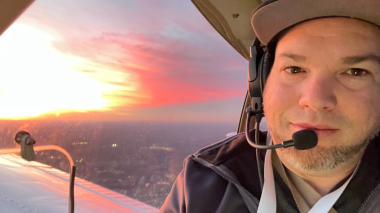A cervical cancer diagnosis
“I had no signs or symptoms,” says Callaway. “I had my annual gynecology visit and my Pap smear detected some abnormal cells.”
She underwent additional testing and eventually a biopsy that confirmed a stage IIB cervical cancer diagnosis.
Callaway is thankful she didn’t put off her yearly gynecologic exam, especially since she was diagnosed just before the COVID-19 pandemic hit.
“I literally wouldn’t have known I had cervical cancer if I hadn’t had my screening,” she says.
After getting her diagnosis, Callaway immediately called her friend and neighbor, Dr.Jubilee Brown, a gynecologic oncologist at Atrium Health Levine Cancer Institute. Callaway says Brown explained what would happen next and told her she would ultimately be OK.
Callaway soon underwent a radical hysterectomy, during which Brown removed her uterus, fallopian tubes and nearby tissue. Brown also removed some pelvic lymph nodes to determine if the cancer had spread beyond the cervix.
All surrounding tissue and lymph nodes were normal and cancer-free. This meant Callaway didn’t need radiation or chemotherapy, but would be monitored for several years to ensure the cancer didn’t return.
The United States went into lockdown because of the pandemic just days after her surgery. Callaway’s mom was in town from Miami to help her recover and her children were home from school.
“The timing was crazy—I feel fortunate,” she says.
But even with a cervical cancer diagnosis and pandemic, life was about to throw another curveball her way.
A breast cancer diagnosis
Callaway recovered from surgery and returned to work at the wound care clinic in June. At the end of July, she went for her routine screening mammogram.
“I’d already had a mammogram two years prior and it was totally normal, no problems,” she says. “I didn’t feel a thing. I had no lumps, bumps or pain.”
But soon after the screening, Callaway got a call that her mammogram was abnormal and she needed to return for more images. After her X-rays, the radiologist met with her and said she had some concerning breast calcifications and would need a biopsy. She had two biopsies on the same day.
A few weeks later, Callaway got a call that she was positive for ductal carcinoma in situ (DCIS), which is considered an early form of breast cancer.
Undergoing breast cancer surgery
Brown recommended Callaway meet with Dr. Lejla Hadzikadic-Gusic, a breast surgical oncologist at Levine Cancer Institute. Hadzikadic-Gusic reviewed Callaway’s case and determined she wasn’t a candidate for a lumpectomy.
“Dr. Callaway had multicentric disease, which means she had cancer spreading out over several portions of her breast,” says Hadzikadic Gusic. “Given the span of disease, she was not a good candidate for a lumpectomy given the tumor-to-breast ratio. She would not have had a good cosmetic outcome given the amount of disease present.”
Instead, Hadzikadic Gusic recommended a mastectomy and lymph node removal, though the procedure required careful planning because of Callaway’s unique circumstances. Hadzikadic Gusic worked closely with radiation oncology and plastic surgery colleagues to help Callaway achieve the best medical and cosmetic results.
“There were calcifications very close to her nipple, so I had to adjust the surgery incision and technical planning to combine a good oncologic outcome as well as the most optimal cosmetic outcome,” says Hadzikadic-Gusic. “I was pleased we were able to give her both.”
One of the benefits of being at a high-volume center like Levine Cancer Institute is that the team often sees patients for a second or third opinion. This meant they had the experience to treat a more complex case like Callaway’s.
“Challenging cases are more the norm than the exclusion,” says Hadzikadic-Gusic. “This keeps our expertise at a high level and allows us to offer our patients the best care.”
Recovering from a mastectomy
After undergoing a mastectomy in October 2020, Callaway recovered for two months and had reconstructive surgery in December.
“The fortunate thing was my breast surgeon was able to get completely clean margins even though the cancer went up very close to the skin,” says Callaway. “My lymph nodes were negative as well.”
These results meant she didn’t need radiation or chemotherapy.
Were the two cancers related?
“Both cancers were completely unrelated to each other,” says Callaway. “I had a full genetic panel that was pretty much normal. They found no genetic risk factors for breast cancer. Other than my grandmother having breast cancer when she was in her late 60s, I don’t think we have a lot of breast cancer in my family. It was totally coincidental.”
The importance of cervical and breast cancer screenings
Both of Callaway’s cancers were caught by screenings, so she is passionate about raising awareness of when to get screened.
“I wasn’t private about my diagnosis because if I could encourage even one person to get their screening tests, that was a win,” she says. “I got many messages from friends who said because of my message, they were scheduling their mammogram.”
Mammograms and cervical cancer screenings can detect cancer before it causes symptoms and when it’s in its earliest, most treatable stages.
“I thought I was a perfectly healthy 40-something and when all of this happened, I felt fine,” says Callaway. “I could have put it off with everything going on [with the pandemic], but it’s important to go to your routine appointments and get your screening and preventive tests. These tests can detect things much earlier than if you wait until you feel something.”
As a first-generation Cuban American, Callaway is passionate about reducing the stigma around mammograms among Hispanic women.
“I can’t speak for all Hispanic people, but in my family, there’s generally a feeling that cancer is a death sentence and I think there’s a fear of discovering it,” she says. “This can lead to an avoidance of seeking the diagnosis, almost like if ‘I don’t know about it, it’s not there and I can keep living my life.’”
Callaway notes that access to care, health literacy and language can create barriers to health care for many Hispanic people.
“Latina women are more likely to be diagnosed with breast cancer at a younger age and with more aggressive disease,” she says. “They are also 30% more likely to die from breast cancer than non-Hispanic white women, despite the fact that breast cancer incidence is overall lower.”
Mammogram screening guidelines
The American Cancer Society recommends:
- Women ages 40 to 44 have the option to start annual mammograms.
- Women ages 45 to 54 should get yearly mammograms.
- Women 55 and older should get mammograms every two years or continue yearly screenings.
- Women should continue mammograms as long as they are in good health and are expected to live at least 10 more years.
It’s also essential to pay attention to how your breasts look and feel. If you notice any changes, such as lumps, bumps, pain, discharge, bleeding or change in size, talk to your primary care provider or gynecologist immediately.
Cervical cancer screening guidelines
Two screening tests can help prevent cervical cancer or detect it in its earliest stages:
- Pap test (also called Pap smear): This test looks for abnormal or precancerous cells in the cervix. The Centers for Disease Control and Prevention (CDC) recommends starting Pap tests at age 21. If your results are normal, you may be able to wait three years until your next Pap test.
- HPV test: This test detects human papillomavirus (HPV), which can cause abnormal cell changes that can lead to cervical cancer. If you’re 30 to 65, ask your doctor if you should also get an HPV test along with your Pap test.
If you notice symptoms like abnormal vaginal bleeding, bloody discharge, pelvic pain or pain during intercourse, talk with your health care provider.
Looking to the future
Callaway is grateful for her support system, including her physicians, family, friends and neighbors. She also notes that there are many in-person and virtual support groups, so if you are facing a cancer diagnosis, don’t hesitate to seek support.
Her experience as a patient has renewed her passion for practicing medicine and informs how she cares for patients.
“Some of the things I experienced as a patient made me more attuned to the way I care for people,” she says.
When she’s not caring for patients, Callaway enjoys spending time with her family, including her husband, Dr. David Callaway, an emergency medicine physician at Atrium Health, and their two daughters, ages 7 and 9. She enjoys exercising, traveling and spending time with extended family and friends.
This October, Callaway will participate in local events to raise funds for two breast cancer organizations in the area. She also served as the honorary captain at a Charlotte Football Club match where she was able to share her message of breast health to a diverse audience!
“My breast cancer diagnosis has renewed my energy for life and the feeling that we only get one chance at this,” she says. “Be kind, spend time with your loved ones and do what you enjoy doing in life.”
Learn more about breast cancer care at Atrium Health Levine Cancer Institute.



